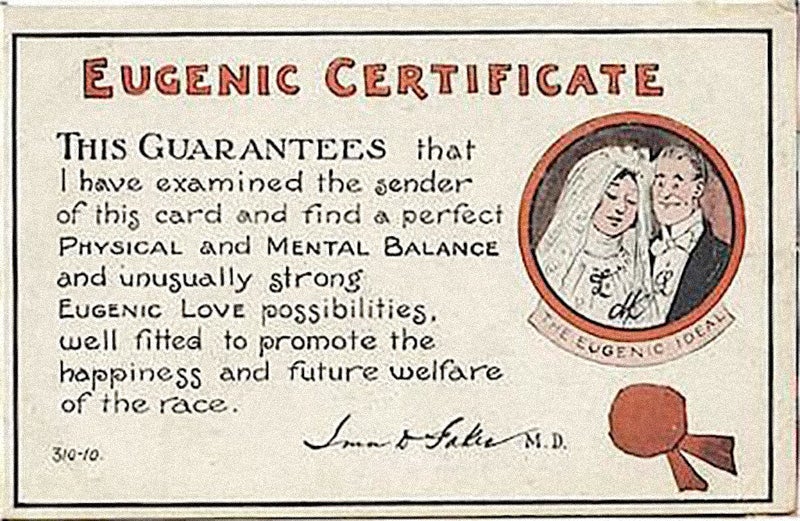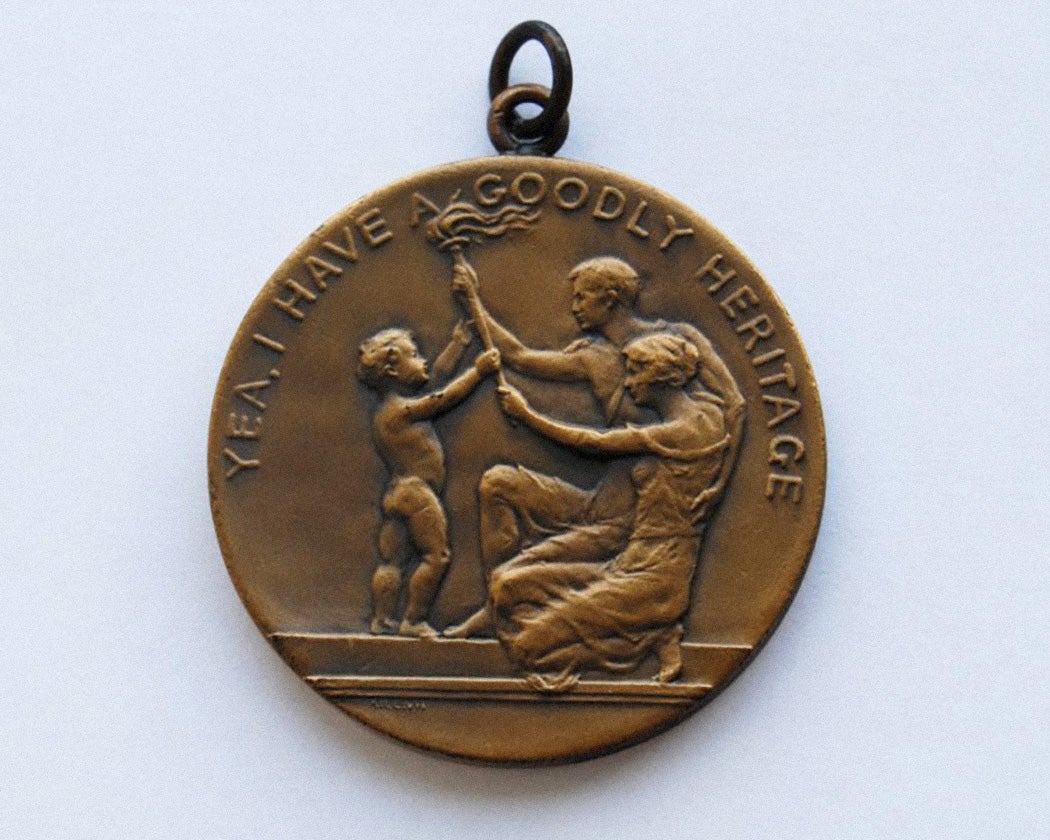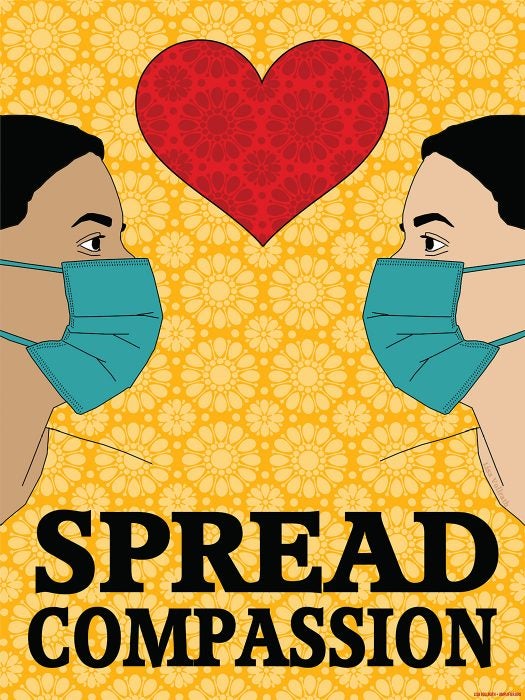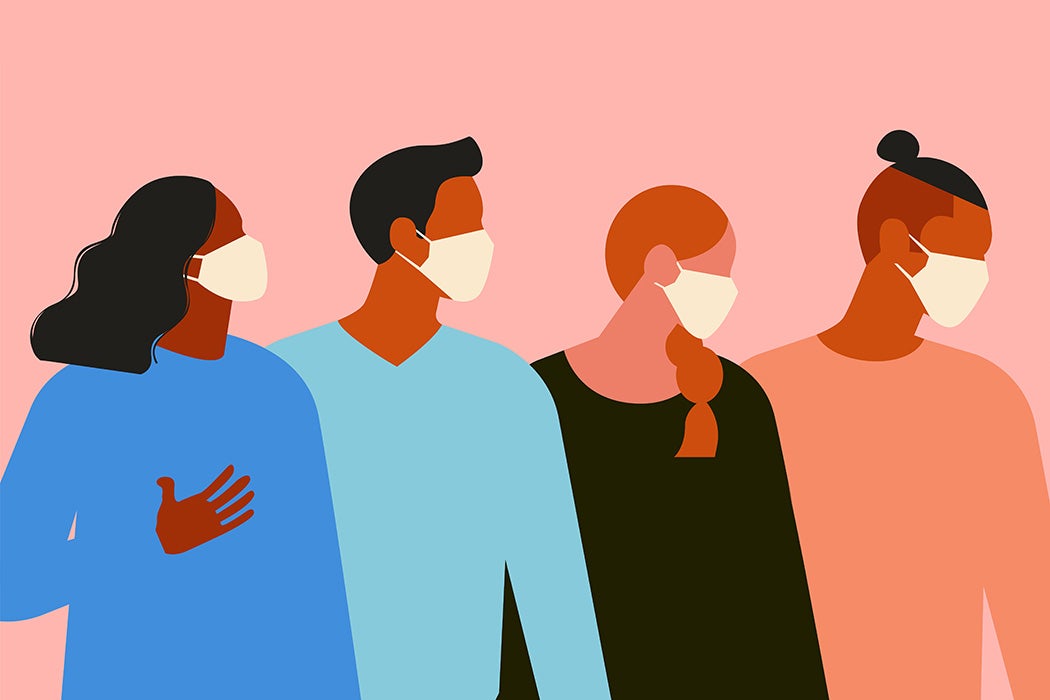About a decade before he published The Great Gatsby, F. Scott Fitzgerald tried his hand at musical theater, writing the plot and lyrics for a college production called Fie! Fie! Fi-Fi! It was 1914 and Fitzgerald was in his second year as an undergraduate at Princeton. The musical was an upbeat romantic comedy filled with quippy dialogue. But one song—titled “Love or Eugenics”—highlighted one of the era’s anxieties about the disconnect between personal pleasure and public health.
In the song, two women spar wits as they disagree about what kind of woman is most desirable to men. Are potential suitors more drawn to the sturdy and sensible Clover who boasts “no fashionable bustle but plenty of muscle”? Or would they prefer the popular fashion-savvy Celeste, “a maiden born to vex” and whose cosmetically enhanced beauty also makes her the “queen of the feminine sex”? The two women conclude the song with a chorus, addressed to the audience, that summarizes this quandary of modern love:
Ladies, here’s a problem none of you can flee,
Men, which would you like to have come and pour your tea?
Kisses that set your heart aflame,
Or love from a prophylactic dame.
Ladies, take your choice of what your style shall be.
There is plenty to say about the obvious heterosexism (not to mention the plain old sexism) of this framing. But even more striking is the casual ease with which the teenaged Fitzgerald manages to incorporate a word as clinical and cumbersome as “prophylactic” into the verse’s otherwise simple and light-hearted diction. What exactly is a “prophylactic dame”?
Deriving from the Greek words for “before” and “guard,” prophylaxis refers to a variety of precautionary measures designed to predict and preempt a negative outcome, primarily in a medical context. Vaccines fortify the body against certain viruses; condoms and other prophylactic barriers can prevent pregnancy and the transmission of STIs; and routine screenings like mammograms and colonoscopies are designed to detect and neutralize issues in their early stages.
However, at the time that Fitzgerald wrote the lyrics quoted above, prophylaxis was most frequently invoked as an extension of eugenic ideology and practice. Marshalling the white supremacist science of “racial hygiene,” doctors became amateur sociologists recommending “prophylactic” solutions to social problems. These solutions included both “negative eugenics”—the institutionalization and forced sterilization of prostitutes, poor women, women of color, and disabled people—as well as “positive eugenics,” which attempted to increase the birthrate among white, upper middle class, nondisabled, and neurotypical families.
Weekly Newsletter
Consider, for example, these remarks by Dr. R.M. Funkhouser which link the science of preventative medicine to private decisions around romantic courtship. This advice appeared in a 1913 issue of the Journal of the Missouri State Medical Association just one year before Fitzgerald wrote “Love or Eugenics”:
The quality of human beings should count and not quantity. Is it not wiser and better that prophylaxis precede than wholesale destruction follow?… The general knowledge of the laws of heredity should be more largely disseminated and marriage should primarily depend on the desire to produce ‘worthy’ offspring with the best qualities.
To be clear, when Funkhouser weighs the benefits of “prophylaxis” against a future of “destruction,” the calamity he is referring to is the imagined contamination and degradation of white bloodlines. Prescriptions like these were echoed in countless medical publications of the period and strongly influenced both public policy and popular culture. The same year, the United States Surgeon General, Rupert Blue, advocated for the use of “eugenic marriage certificates,” which would certify the mental and physical health of both partners in advance of their wedding.

By the end of the decade in which Fitzgerald was writing, state fairs across the country would begin to hold “fitter families” contests, transforming these medical recommendations into a recreational pastime. Making an anxious spectacle of the usually unmarked category of whiteness, middle class families competed for “top honors” by undergoing a series of mental and physical evaluations designed to test their eugenic fitness. Winners were announced and ribbons were awarded—though any family that scored a B+ or higher was presented with a medal bearing the inscription, “Yea, I have a goodly heritage.”
Arguably, Fitzgerald is poking fun at practices like these; his lyrics appear to satirize prophylactic marriage and invite skepticism around the wisdom of applying the “laws of heredity” to mate selection. While Dr. Funkhouser would no doubt advocate choosing a “prophylactic dame” over “kisses that set your heart aflame,” the plot arc of the musical validates the opposite outcome as the charming Celeste wins out over the eugenically “fit” Clover.

These critiques also show up in Fitzgerald’s later novels, as he places eugenic sentiments in the mouth of deeply unlikeable characters like Tom Buchanan in The Great Gatsby (1925) who proclaims that “if we don’t look out the white race will be — will be utterly submerged. It’s all scientific stuff; it’s been proved.” Tom’s appeal to racial prophylaxis is discredited in the novel, along with the eugenic science that motivates it.
In my book, Vulnerable Constitutions: Queerness, Disability, and the Remaking of American Manhood (2019), I coin the phrase “anti-prophylactic citizenship” to name this kind of skepticism toward public health mandates. Put simply, anti-prophylactic citizenship describes the way some writers have advocated for more radical forms of belonging and kinship through a rejection of medical authority. Fitzgerald’s song which encouraged his audience, however flippantly, to choose “love” over “eugenics” is one of the more straightforward examples. But for the most part, the anti-prophylactic visions that I traced came from queer, disabled, black, and trans writers who struggled to feel safe or cared for by medical professionals.
James Baldwin, for example, was deeply troubled by the violence of the DSM (Diagnostic and Statistical Manual of Mental Disorders) which tended to either overlook or actively target black men in its diagnostic criteria for various mental disorders. In one particularly damning essay, Baldwin compared psychiatry to the prophylactic walls of a bomb shelters, both of which, he believed, offered technologies for insulating white liberals against authentic engagements with their own and others’ racism. Samuel Delany takes a similar anti-prophylactic stance when he dismisses the way panic over AIDS was used as a justification to “clean up” up New York City’s gay cruising zones. Against the restrictive zoning laws that attempted to sanitize and gentrify public space, Delany defended public sex between strangers as a valuable form of cross-class intimacy.
Delany, of course, does not literally advocate spreading HIV. Yet it is no coincidence that he names this model of cross-class intimacy “contact” with all its epidemiological connotations of tracing, transmission, and spread. In these and other examples that I discuss in the book, anti-prophylactic citizenship is often more figurative than literal, a fantasy of how community can form organically through unexpected vectors and across multiple lines of race, sexuality, gender, class, and ability. Embracing viral metaphors, these writers saw the willingness to remain open to infection as both an ethics and a powerful way to describe a broader willingness to be transformed—physically and psychologically—by your encounters with difference.
As we navigate our current public health crisis, it may feel counterintuitive or even dangerous to imagine infection as a site of connection and community. Today, prophylaxis has become a necessary part of our everyday life as we mask up in public, disinfect groceries, and keep a safe distance from loved ones. But unlike the prophylactic boundaries set in place by eugenicists, these recent practices of heightened vigilance are gestures of love and care—not only for ourselves but for members of communities disproportionately affected by the virus’s spread. Meanwhile, the partisan controversy that has emerged in opposition to mask-wearing is dominated by a dangerous rhetoric of individualism.
In this context, it is necessary to make careful distinctions between the libertarian entitlement of those who refuse to wear masks and the anti-prophylactic visions of queerness, disability, and anti-racism that I describe in my book. When Baldwin or Delany urge their readers to disobey doctors’ orders, it is not out of disregard for the welfare of others but because they understood the way medicine has been used systemically to discount marginalized bodies.
Most importantly, these writers saw contagion as a metaphor for community—proof that we exist within an interdependent network and not as autonomous disconnected islands. As AK Thompson puts it in a recent interview about the relationship between the politics of COVID and the politics of anti-racism,
with the pandemic mask, the myth of the individual comes face to face with the reality that you’re in my lungs, and I’m in yours. Here, politics reveals itself to be fundamentally respiratory. This was highlighted when Black Lives Matter turned Eric Garner’s dying words, ‘I can’t breathe,’ into a rallying cry.
When we place a fabric shield between our bodies and the bodies of those around us, we are not policing borders as much as we are acknowledging interconnectedness. But this is precisely the opposite message of anti-mask protesters whose opposition to literal prophylaxis speaks to a deeper commitment to the self as an isolated unit—what we might call a quarantining of the soul. When both anti-maskers and police violence apologists advocate for a return to business as usual, their arguments rest on the premise that a portion of the population is expendable in the name of public safety and economic security. In Fitzgerald’s terms, they are choosing eugenics over love.
The same can be said of the now-infamous duo, Mark and Patricia McCloskey, who claimed self-defense after they pointed firearms at BLM protesters who happened to walk past their mansion in late June. As Kea Wilson clarifies in her essay about the spatial politics that frame the incident, it would be a mistake to ignore the gentrified “backdrop for their act of racist aggression: a gated, private street with an explicitly anti-Black history, located in the dead center of a major city.” A recent picture shows the McCloskeys’ broken gate, now surrounded by several new freestanding barricades, each individually wrapped in caution tape: a parody of prophylactic hypervigilance.

In this context, I prefer to think of mask-wearing not exactly as prophylactic medicine but rather as an expression of what Carol J. Adams has called “anticipatory care.” Like prophylaxis, anticipatory care requires forethought and vigilance; but unlike barriers intended to patrol and police, anticipatory care asks how we can be of service to our loved ones and our communities. The anti-prophylactic virtues of anticipatory care might be summarized in visual terms by Lisa Vollrath’s recent “Spread Compassion” postcard series in which two masked individuals, despite their protective barriers, commune with one another through a connecting trail of hearts.
This framing of compassion as something that can “spread” like virus also calls to mind sci-fi writer David Brin’s 1987 short story “The Giving Plague.” In it, a biologist named Les discovers a new virus which he names Acquired Lavish Altruism Syndrome (ALAS) because its sole symptom—an intense desire to donate blood—cultivates an altruistic self-image in those who contract it, thus inspiring additional acts of goodwill. Rather than announcing his discovery, Les allows the virus to spread unchecked, believing it to be “our last chance, a final opportunity to become better people, to learn to cooperate before it’s too late!” By the end of the story, one quarter of the world’s population has been infected, and the narrator reflects:
“Peace treaties were signed. Citizens of the industrial nations voted temporary cuts in their standards of living in order to fight poverty and save the environment. Suddenly, it seemed, we’d all grown up.”
In the initial weeks following the outbreak, I found myself returning to these passages from Brin’s story. As we all adjusted to life during lockdown and as serious conversations began to open up around disability access and universal basic income, I wondered if COVID had the potential to inspire a similar national and global awakening.
Four months later, it’s hard to tell whether the new normal we’re in the process of fashioning will live up to that promise. As states reopen their economies alongside rising infection rates and as officials rationalize the inevitable death toll of sending children back to their classrooms—but also as protests against police violence continue to inspire necessary transformations and as confederate monuments are pulled from their pedestals—it remains to be seen if we, too, are on the verge of growing up.
Support JSTOR Daily! Join our new membership program on Patreon today.







